This is the third in a series of blog posts focused on the value of art in our lives, and the role art can play in resisting the test and punish model of education. See the intro and links to other posts in the series here.
By Clyde Gaw.
Eight year-old Frank helps five of his classmates select materials for a large floor sculpture. “Dude! We added new designs to it. Look we got things like new support beams!” Second grade classmate John watches the action, “How are you making this thing? Can I help you?” Frank replies, “You could. You could put something down here on it.” Working with wooden blocks, chairs and benches, Frank and six of his classmates are constructing a 20 square-foot version of the Tacoma Narrows Bridge. I had been observing the team from a distance working out their engineering problem and moved closer to ask them a question. “Aren’t you concerned about the safety of your bridge?” The boys respond, “It’s safe! It’s safe! It’s not that bad, you’ll only fall two thousand feet!” Eight-year old Ken offers new information to the story, “The Tacoma Narrows Bridge collapsed when it was 4 months old. It sadly collapsed while a poor dog was trapped inside a car. He later fell at the bridge. He did not make it out alive.”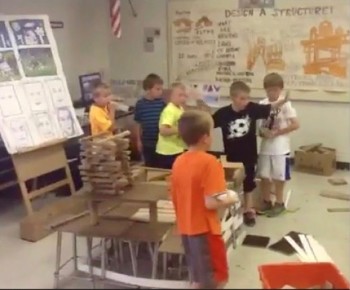
Fascinated by their collaborative spirit I asked the boys another question. “What a tragedy! What inspired you to build this bridge?” Ken explained, “This is the ‘new’ Tacoma Narrows Bridge. The old Tacoma Narrows bridge video is on the Internet. So we watched the video and we got inspired by it so we built this one.” The energetic builders continue stacking and weaving new parts into their structure. They fabricate trusses and columns out of chairs, wooden blocks and strips of recycled plastic. I congratulate the boys for initiating such a physically large project then document their progress with photographs. “You guys are something else!” I scan the room to observe the rest of the class.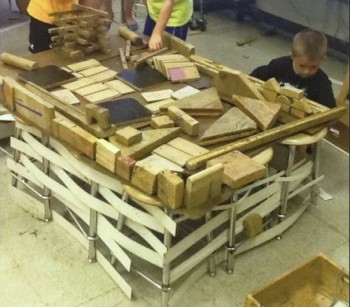
Moving about freely, the children have set up their own workspaces and engage in self-directed art projects. They communicate easily with each other, working with a variety of materials, tools and art making techniques. Best friends Kelli and Susan are drawing pictures of their neighborhoods from memory. Janine is painting images of people on a sheet of cardboard. Kaylee, who wants to be a veterinarian when she grows up, is drawing a giraffe. James, who is in competition with his brother to draw the most ferocious monster ever, renders a dragon with oil pastels. Emilee who is interested in fashion, knots yarn to create a bracelet while her best friend Korra is working on what appears to be an abstract painting with green and blue tempera paint. She adds packing tape to the surface. Korra announces she is experimenting with “shiny surface art.” After completing her experiment, the eight year old writes in her journal, “ Art is a part of being creative. When your [sic] creative, your [sic] doing better than you are when your (sic) not.”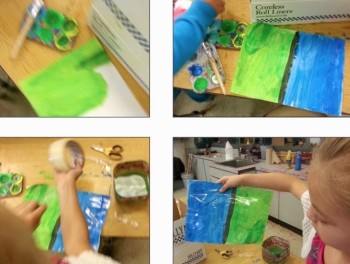
I offer congratulations to Korra on her attempt at “shiny surface art” and continue documenting children in action with my camera. There are twenty-two students in the room working solo or self-initiated groups.
Time is of the essence. The forty minute class is set up for five minutes of general instruction, thirty minutes for art making and five minutes for clean up. After twenty-five minutes of intense activity, I announce, “It’s almost clean-up time!” In unison, a low groan rises from the mouths of the eight year olds, “Nooooooooooooo!!!!” We only see you once or twice a week! Why does art have to be so short? We don’t want to leave!”
This is not the first time resistance to leaving the art room has been observed. I’ve been noting this phenomenon since 1984. Children are naturally creative, and disrupting a child’s flow-state after they have initiated a creative activity is the last thing I want. Heightened states of consciousness during creative learning activity enable children to become independent operators and attain executive functioning skills. Children need longer, deeper creative experiences than schools currently afford. Korra’s artist statement addresses this point: “When your creative, your doing better than when your not.” What does “when your not” mean? What is this child experiencing during the rest of her school experience that is troubling her?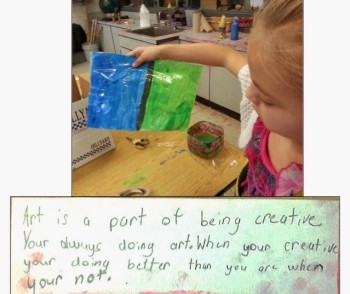
At the end of the day, I ask myself, if art experiences optimize developmental pathways and provide learning experiences that allow students to make sense of content, why are fine arts programs not fully funded and supported by federal and state policy makers whose mantra is “We should do what’s best for children?” President Barack Obama, whose presidential theme of “change” propelled him to the White House in 2008, defaulted on that promise with RTTT, an initiative resulting in the de-emphasis of arts learning and new emphasis on testing and data collection. Despite happy talk from politicians about arts education, federal and state lawmakers should know if schools and educators are going to be penalized for low standardized test scores, a school’s curricula structure is going to emphasize test-taking skills in a myriad of ways including increased time spent on tasks and subjects preparing for tests.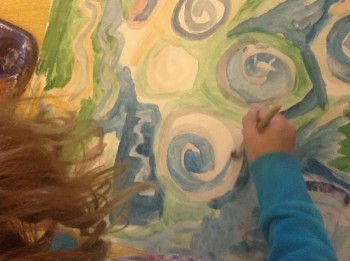
In the classroom, I look at my watch. “Children, it’s clean-up time. The next class has arrived and they are waiting outside for their turn in the art room.” “Tell them to wait,” chirps Frank, “We don’t want to go!” After clean up, Frank’s class lines up at the door and reluctantly waves good-bye while the next class moves in for another 40-minute art experience. This sequence is repeated 37-39 times a week, for 36 weeks. My thoughts race back to a comment a student made to me a two years earlier, “Art should be….like the whole school!” What would happen if students spent most of their day learning through creative experience? What would that look like?
At the end of the day, I review photo-documentation of student art-making activities in our studio where child initiated ideas to build, paint, draw, sculpt, act, sew, write or develop other trans-disciplinary ideas are honored. Democratic education is emergent and means children have a voice and co-collaborate in the design of the curricula experiences they participate in.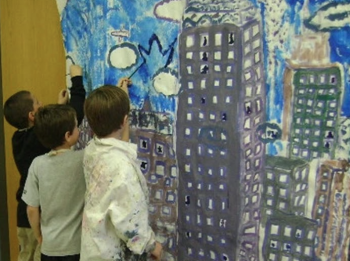
After decades observing children in studio settings devoted to self-expression in art, there is much evidence to conclude the mind is a biologically unique organ. Howard Gardner’s theory of mind, which states human beings are biologically endowed with unique intellectual and creative capacities, is perfectly illustrated in our art program. Children are not homogeneously constructed.
Children thrive in fine arts settings because art, music, theatre and dance are the first language of humans. It is not by accident that educational experience is optimal when integrated through multi-sensory learning experience. There is a biological basis for memory formation and it has everything to do with multi-sensory experience. Research in physiology by 2000 Nobel Laureate, Eric Kandel reveals neural networks are strengthened and expanded when learners engage in sensory-based learning experience. From this educator’s perspective, Kandel’s research means fine arts experiences are critical, foundational experiences in the development of mind.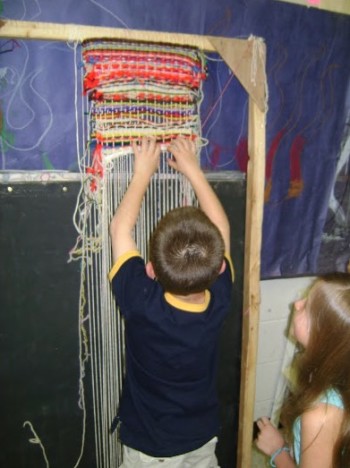
In his 2010 survey of 3412 art teachers, Dr. Robert F. Sabol reports test-centric policies have marginalized funding and support for art education programs across the U.S. Since 2010, schools have implemented more test centric curricula in order to meet the demands of state and federal testing mandates. What is the future of creative learning experience for children in the U.S.? What does the marginalization of arts education funding say about policy-makers understanding of learning and human nature? It tells me those who control education policy have a limited conception of the mind. How children are educated should NOT be determined by corporations or their foundations whose primary interests are ultimately profits.
The roots of cognitive science, the science of mind, brain and learning, have been in existence since Socrates, Plato and Aristotle postulated on the essence of the human psyche over 2500 years ago. We know mind, body and spirit are affected by early learning environments and the constant evolving present. Where are the opportunities for students to synthesize knowledge and develop intellectual cohesion of their learning? The idea children will attain full intellectual potential by structuring 15,000 hours of formative K-12 experience around the practice of selecting single correct answers on continuous selected response data-driven assessments is absurdity.
It is ironic as the U.S. Congress readies itself to re-instate the Elementary and Secondary Education Act, citizens will have had only a few days to contact legislators on the ESEA re-write while debate on the floors of the U.S. House of Representatives and U.S. Senate will be limited. Will federal and state legislators sign off on policies that continue to emphasize the fragmentation of knowledge through various forms of behavior modification and competency-based standardized testing?
Policymakers and corporate profiteers responsible for the intensification of test-centric curricula experience believe their reforms are benign. They are wrong.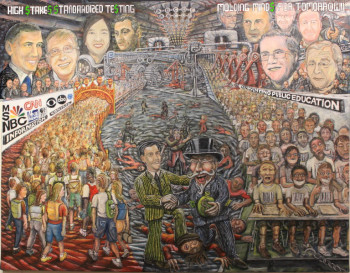
Since 2002 non-consensual, data-driven seat-work has produced frightening results. The National Institute of Health reports over 20% of 13-18 year olds in the U.S. will live with a mental illness condition. Voter turnout rates for young voters in the U.S. are consistently abysmal despite eligibility to vote. School bullying and teen suicide rates are on the increase. Juvenile crime rates and a school to prison pipeline reflect a narrowed curricula that disengages and disaffects significant numbers of children.
Market-based efficiency innovations whose output is single correct answers or short answers on standardized forms of assessment will continue to marginalize creative learning experience. Authentic fine arts learning experiences are powerful, trans-disciplinary experiences that provide natural pathways for the unique in-born endowment, interests and genius of children to unfold. Fine arts experiences have the potential to ameliorate violent tendencies and unleash the emotional drive of children. Increasing fine arts education is in the best interest of the Nation’s children and is the foundation of real education reform. No more failures of imagination!
Clyde Gaw M.A.E., has taught art in K-12 settings at Indianapolis Public Schools and Southern Hancock Schools in Central Indiana for the past 31 years. He is the advocacy chair for the Art Education Association of Indiana and a member of Teaching for Artistic Behavior. Clyde is a graduate of Indiana University and Herron School of Art, lives in Indianapolis and is also the author of “The Secret Art of Boys,” chapter 11 of The Learner Directed Classroom: Developing Creative Thinking Skills Through Art.
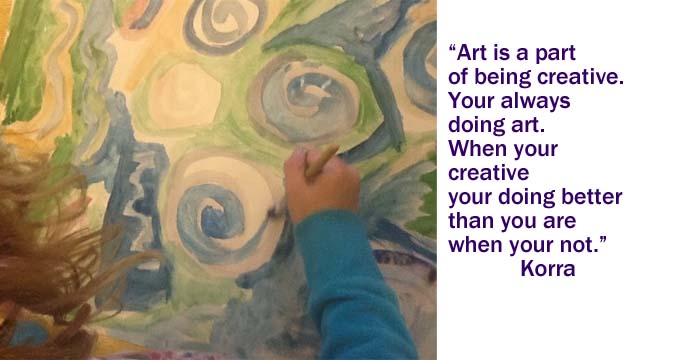




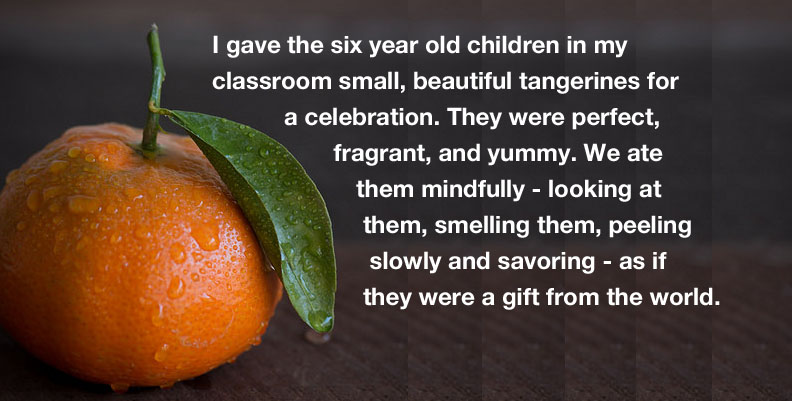
Leave a Reply